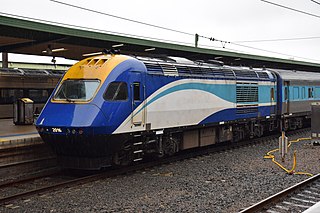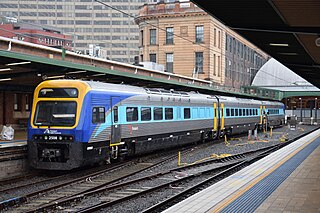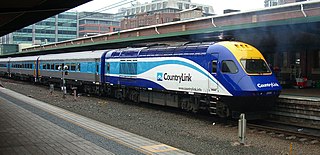
CountryLink was a passenger rail and road service brand that operated in regional areas of New South Wales, and to and from Canberra, Brisbane and Melbourne. Originally created as a business unit of the State Rail Authority of New South Wales, it later became a subsidiary of RailCorp. CountryLink operated rail services using XPT and Xplorer rolling stock, with connecting coach services operated under contract by private operators.

The Southern Highlands Line (SHL) is an intercity rail service operated by NSW TrainLink that services the Macarthur, Southern Highlands and Southern Tablelands regions of New South Wales. First operating in 1869, the service runs from Campbelltown across the Main Southern railway line through to Goulburn, with peak hour services extending the route to Central. The railway service operates alongside a bus route from Picton to Bowral, operating on the route of the Picton – Mittagong loop railway line, and a regional coach service from Bundanoon to Wollongong on the South Coast Line, operating on the corridor of the Unanderra–Moss Vale railway line.
The railways of New South Wales, Australia, use a large variety of passenger and freight rolling stock. The first railway in Sydney was opened in 1855 between Sydney and Granville, now a suburb of Sydney but then a major agricultural centre. The railway formed the basis of the New South Wales Government Railways. Passenger and freight services were operated from the beginning. By 1880, there was a half hourly service to Homebush.
The Mungindi railway line is a railway line in northern New South Wales, Australia. It branches from the Main North line at Werris Creek station and heads north-west through the towns of Gunnedah and Narrabri before reaching Moree which for many years was the railhead before the extension to Mungindi was constructed. The line is currently truncated to Weemelah between Moree and Mungindi. Passenger trains still operate to Moree, and goods trains operate to Camurra. As of 1 September 2009, services have been suspended between Camurra and Weemelah. The line between Werris Creek and Moree is also known as the North-West line.

The New South Wales XPT is a class of diesel-powered passenger trains built by Comeng and ABB. Based on the British Rail-designed High Speed Train, each XPT set comprises two XP power cars in a push-pull configuration and, between them, between four and seven passenger carriages.

The Xplorer is a class of diesel multiple unit trains built by ABB. Initially entering service in October 1993 with CountryLink, the Xplorers are mechanically identical to the Endeavour railcars, though feature a higher level of passenger amenity. All 23 carriages were built in the Dandenong rolling stock factory. The Xplorers currently operate under NSW TrainLink, running on the regional Main North, Main Western and Main Southern lines throughout New South Wales.

The Silver City Comet was a train service that operated from September 1937 until November 1989 between Parkes and Broken Hill in western New South Wales. It was the first air-conditioned train in Australia.

Yass Junction railway station is a heritage-listed railway station on the Main Southern line in New South Wales, Australia. It serves the town of Yass. The station is not in the town itself but is located approximately four kilometres away near the Hume Highway. The station was listed on the New South Wales State Heritage Register on 2 April 1999.

The Inter-Capital Daylight was a passenger train that operated between Australia's two largest cities, Sydney and Melbourne from March 1956 until August 1991.

The 900/800 class railcars were diesel multiple units built by the New South Wales Government Railways between November 1951 and November 1960.

The Riverina Express was a passenger train operated by the New South Wales Government Railways between Sydney, Griffith and Albury from September 1949 until November 1993.

The Canberra Monaro Express was a passenger train operated by the New South Wales Government Railways between Sydney, Canberra and Cooma from May 1955 until September 1988.

The Central West Express is the legacy name for the Australian passenger train operating on the Main Western line in New South Wales from Sydney to Dubbo.
The Southern Highlands Express was an Australian passenger train operating on the Main South line in New South Wales from Sydney to Goulburn.

The Northern Tablelands Express is the legacy name for the passenger train service in Australia between Sydney and Armidale, and between Sydney and Moree, operated by the New South Wales Government Railways and its successors since June 1941.

The North Coast Daylight Express was an Australian passenger train operated by the New South Wales Government Railways from November 1951 until February 1990.

The Grafton Express is an Australian passenger train operated by NSW TrainLink between Sydney and Grafton via the North Coast line.
The Brisbane Limited was an Australian passenger train operated by the New South Wales Government Railways between Sydney and Brisbane from 1888 until February 1990. The route is now served by an unnamed XPT service.
The XPT Service Centre is a railway depot operated by NSW TrainLink in Tempe, Sydney.

Canberra, the capital city of Australia, is served by a heavy rail line to New South Wales, and a light rail system, Canberra Metro. NSW TrainLink regional trains run from Canberra to Sydney.












